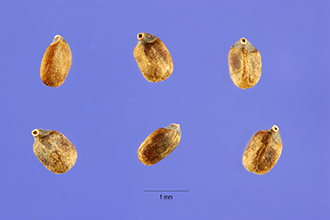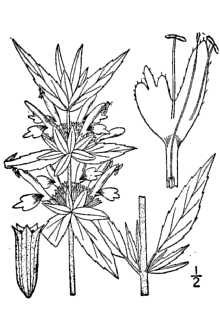Spotted Beebalm
Scientific Name: Monarda punctata L.

| General Information | |
|---|---|
| Usda Symbol | MOPU |
| Group | Dicot |
| Life Cycle | AnnualBiennial, Perennial, |
| Growth Habits | Forb/herbSubshrub, |
| Native Locations | MOPU |
Plant Guide
Alternative Names
Spotted bee-balm
Uses
Ethnobotanic: Dotted horsemint was used by the Meskwaki to treat colds and catarrh in a mixture with the leaves of Ranunculus delphinifolius and the disk florets of Helenium autumnale. This plant, along with other plants were ground into a powder and snuffed up the nostrils to relieve a sick headache. Taken with the roots of Asarum canadense, Euphorbia corollata, and Brauneria angustifolia these plants relieved stomach cramps. The Delaware washed patients' faces with an infusion of dotted horsemint to treat skin problems. They also used an infusion of dotted horsemint to reduce fevers. The Mohegan made an infusion of the plant to reduce fevers as well. The Nanticoke used an infusion of the entire plant to treat colds. The Navajo hung the plant in the hogan for its pleasing odor. Other Uses: Birds are attracted to the nectar, such as hummingbirds.
Status
Please consult the PLANTS Web site and your State Department of Natural Resources for this plant’s current status, such as, state noxious status and wetland indicator values, Use soil moisture sensors to measure the soil moisture of Spotted Beebalm.,
Description
General: Mint Family (Lamiaceae). This herbaceous perennial is 3 to 10 dm. high and thinly canescent. The leaves are lanceolate or narrowly oblong, 2-8 cm. and more or less hairy. The plant has square stems. The flowers are both terminal and axillary and the stamens do not exsert beyond the strongly arched upper corolla lip. The flowers appear in small, compact, head-like cymes of 2-5 or solitary on depauperate plants. The flowers are tubular, and 13-15 nerved. The corolla is pale yellow, spotted with purple and strongly bilabiate. The upper lip is narrow and entire, and is about as long as the throat and slender tube together. The lower lip is broader. © Hugh Wilson Vascular Plant Image Gallery @Texas A & M
Distribution
This plant is found in dry sandy soil from Vermont to southeastern Minnesota, south to Florida and Texas, but missing from most of the Ohio drainage. For current distribution, please consult the Plant Profile page for this species on the PLANTS Web site.
Establishment
When the seeds are ripe, cut off the seed heads and spread them over a clean, dry surface indoors to air-dry for several days. Then place some of the seed heads in a paper bag and shake. Many of the seeds will fall into the bag. Repeat the process with the remaining heads. Next run the seeds and associated chaff through a sieve. Store the seeds in a dry sealed and labeled container or Ziploc™ bag with wet sand or peat moss in the refrigerator that is kept under 40º F for three months. Propagation by seeds: Sow the seeds in a greenhouse in cells (1 and one quarter inches across and 2 and one quarter inches deep) in January no deeper than one-eighth of an inch. Expect them to germinate in one to two weeks. The soil mix can be one-third sand and two-thirds commercial plug mix. Place 5 seeds per cell. Apply a starter fertilizer solution for the seedlings. Water them when the surface is dry to the touch. Note that dotted horsemint is sensitive to over-watering. Keep the seedlings in the cells for 3 to 4 months. Water them when the surface is dry to the touch. Pinch off the tops of the plants several times to encourage a branching and bushier grow habit. Apply a weekly application of an all-purpose fertilizer to the seedlings. When the roots fill the container they are ready for out-planting in the garden. Plant the plants in a sunny, weed-free spot to light shade and in a light, well-drained soil, two feet apart. Water, until rains come. Seeds can also be broadcast on a weed-free surface from January to mid-May in a sunny location. During the first summer of full growth mow the area 3 to 5 times to keep the plants between 8 and 4 inches tall. Mowing also reduces weeds. Propagation by cuttings: Take stem tip cuttings, 3-4 inches long, any time from May to August. Remove the lower leaves and all flower or seed heads and insert the stems into a sand and perlite-rooting medium. Bury each cutting up to the first node. Place the cuttings in an enclosed area and mist them several times a day. In 4 to 5 weeks the cuttings should be well rooted and can be transplanted to pots. Then out-plant the seedlings in the garden in early autumn.
Management
Once established, dotted horsemint still benefits from extra watering during dry summers. Continue mowing the area, once a year, after the hardest killing frosts or the following spring. This keeps woody plants from encroaching and removes plants that have died back. Continue to add leaf mold and compost to your soil, as the plant's shallow root systems spread easily through light soil. Cultivars, Improved and Selected Materials (and area of origin) Seeds and plants of selected dotted horsemint are available from many nurseries. It is best to plant species from your local area, adapted to the specific site conditions where the plants are to be grown. Contact your local Natural Resources
Conservation
Service (formerly Soil Conservation Service) office for more information. Look in the phone book under ”United States Government.” The Natural Resources Conservation Service will be listed under the subheading “Department of Agriculture.”

